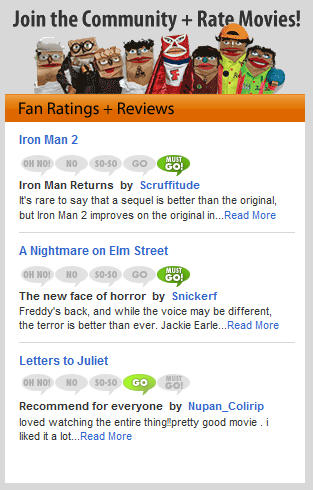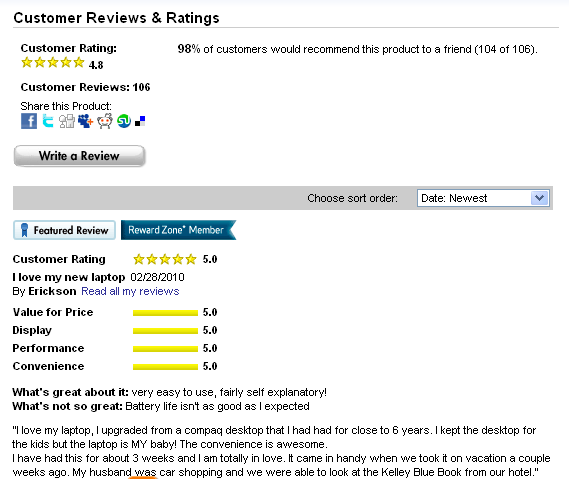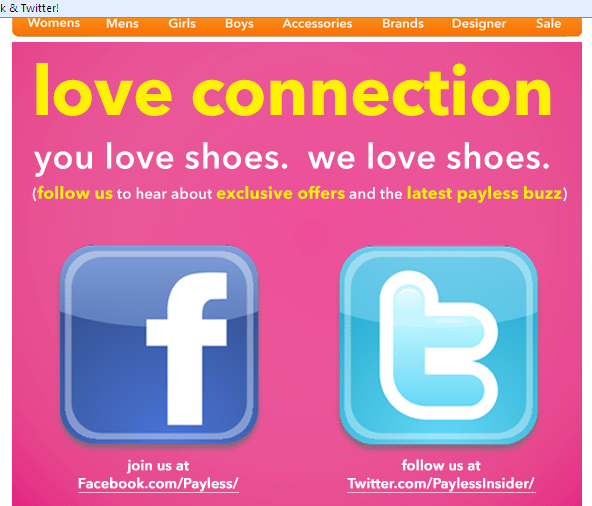This is a guest post by Hugo Guzman.
So here’s the scenario:
A potential client reaches out to your agency. They are interested in this new “social media” thing but haven’t actually dipped their proverbial toes in the social waters yet. However, the CEO read an article in Adage, and as a result, he wants to hit social ground running.
They want a blog, an iPhone app, viral videos, a Twitter handle, a Facebook fan page complete with custom applications, blogger and influencer engagement initiatives, an ad.ly account, and a full, multi-channel viral contest supported by both offline and online media assets, to drive awareness and potential consumers to a fully socialized micro site. It’s going to be their big coming out party on the social media front!

And then we take a look at their primary website.
The design and UI looks like it’s circa 1997. The site does not resolve on smart-phone browsers, and if they sell products online, their e-commerce platform has no social functionality (no review functionality, no commenting functionality, etc). In general, there are no visible calls to action to engage with social channels and little if any interactive assets. Also, after signing up for email alerts, it’s clear that consumer emails also fail to call attention to social channels in any meaningful way.
And worst of all, when recommendation is made, suggesting that these shortfalls on the primary site should be corrected first and foremost, it’s quickly brushed aside as too expensive, cumbersome, or simply not exciting enough when compared to the oncoming, external social media blitz.
Granted, this is an extreme example, but it’s based on the cumulative scenarios I’ve faced when dealing with agency clients in recent years, I think that it’s based on some sort of deep-rooted psychological misgiving. Even seasoned marketers somehow convince themselves that “social media” is an external effort that is separate from the existing marketing agenda, and therefore separate from the existing website and communication stream.
So here’s a simple rule of thumb to live by: if you’re going to launch an external social media initiative – even something as simple as an official Twitter handle – make sure it’s properly supported on your primary website and via your email communications.
And the more intricate your external efforts become, the more social, mobile, and interactive your website must become.
Still not sure how to take action on this rule of thumb? Here are three examples of brands that appear to be taking this message to heart:
Fandango.com
Best-known as a portal for buying movie tickets online, the site is actually quite diverse in terms of its content offerings. You can check show times, read mainstream media reviews, watch official trailers, and get data on individual movies as well as the movie industry in general. That’s good stuff, but what makes the website truly great is the inordinate amount of social and mobile integration.


- Calling attention to social profiles? Check.
- Calling attention to mobile apps? Check.
- Fan ratings & reviews? Check.
- Blog? Check
BestBuy.com
Best Buy is one of the largest and most well-known brick-and-mortar outlets for buying consumer electronics and other tech goodies. They have built their empire on a fairly strong track record of customer service and interaction.
Their website, however, takes this consumer interactive to another level.

- User reviews for products? Check.
- “Share to social” capability? Check.
- Social and mobile profile calls to action? Check.
Payless Shoes
Payless is another well-known brick-and-mortar brand that’s best known for their ability to offer quality shoes for a low price. Most people would consider Payless to be an old-school type of brand, and so one might expect that their marketing techniques and website would mirror that old-school mentality.
However, they’re actually quite ahead of curve, particularly in terms of the way they leverage their email communications to facilitate social media interaction.

- Leveraging email communications to encourage social engagement and following? Check.
Now that I’ve shared some concrete examples, let’s take a moment to talk about the benefits of “fixing your house” first, before engaging in social.
Calls to Action Have Benefits
For starters, leveraging your primary site and email communications is by far the easiest way to reach your existing consumer base, since they are the ones that typically spend the most time visiting your site and reading the emails you send them. For large, Fortune 1000 brands, this is typically a very large group, ranging from a few thousand to a few million individuals. And since many of these folks are implicitly showing affinity for your brand (since they are typically paying customers) they are usually the most likely to follow you on Twitter, “like” you on Facebook, leave product reviews, download your iPhone app or comment on your corporate blog. They are also the most likely to pass the word along to their circle of friends, family, and acquaintances (a prerequisite to “going viral” within social channels).
However, if your website and email messages don’t call attention to these features you’ve lost out on the opportunity to reach these folks and make these things happen. And since the cost of adding calls to action on a website and/or sending email messages is relatively low (email sends are arguably the least expensive weapons in your marketing arsenal), failing to do so is an almost unforgivable sin for any enterprising social marketer.
Perception of the Brand Benefits
A second key reason to “fix your house” in terms of social functionality has to do with the way consumers perceive brands based on their experience with the brand’s primary website. Roy DeYoung, a well-respected colleague and the VP of Creative Services at my interactive agency, often talks about the disconnect that occurs between the experience a consumer has with a brand in “real life” (i.e. using their product, visiting their storefront, engaging with their service offering, etc.) and the online version of that same brand, and about how the website is often the one and only touchpoint a potential customer will ever have with a particular brand, essentially serving as the sales agent that will help the customer decide whether to further engage with the brand or look elsewhere.
 So for example, one of our clients, a very high-end spa brand, had a site experience that completely failed to communicate the truly sublime experience that one has when actually visiting one of the brick-and-mortar spas. That resulted in a lot of potential customers leaving the site and never getting around to taking a tour of the spa facilities. This is an example of how look, feel, and user interface can impact a consumer’s perception of a brand, but I would argue (as would my colleague) that social media functionality has an equally influential impact on a consumer’s perception.
So for example, one of our clients, a very high-end spa brand, had a site experience that completely failed to communicate the truly sublime experience that one has when actually visiting one of the brick-and-mortar spas. That resulted in a lot of potential customers leaving the site and never getting around to taking a tour of the spa facilities. This is an example of how look, feel, and user interface can impact a consumer’s perception of a brand, but I would argue (as would my colleague) that social media functionality has an equally influential impact on a consumer’s perception.
Not having social and mobile functionality baked into the core of a primary website sends a subtle queue about the nature of the brand and its products or services. It says, “we are not hip, we’re still living in the old days.” Now some might argue that this is a good message to send to certain demographics, but the truth is that even the more old-fashioned consumer segments are becoming socially aware, so failing to offer that functionality could lead to a form of cognitive dissonance that can make consumers weary of your brand and what it has to offer in the “real” world.
Search Engine Optimization Benefits
A third, more subtle, reason to “fix your house” is the impact that social functionality can have on search engine optimization. While not all social functionality will make noticeable impact on your SEO efforts, certain ones like blogging can literally become the centerpiece of a successful SEO strategy. Moreover, if you follow the latest search engine algorithm trends, you know that Google and others are apparently beginning to factor any and all social mentions into their ranking methodologies, and it’s likely that these social signals will become even more influential over time. And as more and more users begin to use their mobile devices as their primary tools for performing searches, implementing mobile user interfaces for a primary website becomes crucial. After all, what’s the point of ranking well in Google if the user that finds you in the search results can’t fully engage with your site from his/her smart phone?
So if you’re guilty of neglecting your primary website and email messaging in favor of sexier, external initiatives, you now know what you have to do to rectify the situation. And if your agency was responsible for guiding you in this misguided direction, it might be time to re-evaluate and find a new, more capable provider.
Hugo Guzman is the Vice President of Social Media & SEO at Zeta Interactive, a full-service interactive agency based in New York City. He can be found blogging regularly at www.hugoguzman.com and tweeting @hugoguzman.
Non-screenshot photos were provided by Shutterstock.




Thanks for the opportunity, Tamar! It’s much appreciated. And keep the great content comin’!
OH MY GOD I have come across this EXACT situation with my company and was looking for an article just like this. Glad I started following your blog, so incredibly helpful.
Thanks for the comment, Lauren! I’m glad you found this article useful. Feel free to reach out to me directly if you have any questions or just want to talk shop in the future.
Great post Hugo, I’m going to keep this one handy if I ever need to bring a potential client back down to earth. It’s another good example of the misconception that social media is “super cheap and all you need is a Twitter account!” Subscribed.
Thanks for the comment and the kind words, Chris!
Don’t hesitate to reach out to me if you have questions or just want to talk shop.
Thank you for this great article. I have had numerous discussions with clients and many do believe that incorporating a social media strategy into their current marketing/communications strategy is important, however their is a lack of willingness to make necessary changes to get the full benefits. I look forward to reading more of your blog.
Hugo,
Thanks for the great post. One of the things I look for nowadays when I visit sites is how well they’re integrating their social network presences. Some companies are doing a good job but there seems to be a huge disconnect when it comes to some of the really big players, too. This was something I noticed a few months back
Debbie Hemley
Excellent article on the holistic, proper approach to implementing social media. The foundation must be there to build on. I look forward to subscribing to your blog and reading future articles! This one was a keeper for sure.
Wow, Hugo. You freakin’ hit the nail on the head with this one. It will certainly resonate with those of us who work with these type of companies; but, many of us are sitting here wanting to scream because it is SO difficult to get it through the heads of the ones making the final decisions on the “house.”
Ever watch HGTV’s Designed to Sell? Yeah, it’s like that but for websites. Outsiders looking in can see that if the site is not engaging, no one is going to engage with it, the people behind it or the product. But the insiders have a difficult time seeing that; they are protective of their baby!
Great article. Hopefully it’ll make some business owners sit up and take notice!
Cheers,
Tia
hugo,
this is really interesting to read your blog right now. i believe that closing the gap between dinosaur sites and the new social media requirements for leading successful online ( and resulting from this offline) businesses is the biggest challenge to come. execs now know that they have to integrate social media into their marketing efforts but they don’t pay the respect it deserves. they believe this is a quick fix with built-in overnight success.
i think it’s a learning curve businesses have to go through, for some it might be painful….
Vaneska, Debbie, Michele, Tia, and Jeanette:
Thanks so much for the comments and the positive feedback. The good news is that if people like us continue to push our employers and clients, we’ll see less and less “dinosaur” non-social web sites and more holistic approaches to building a corporate social presence.
I work with tons of small businesses and what a great piece to pass along. I tell all my clients about this site.
Thanks for the comment, Annice! I’m glad you enjoyed my guest post.
I was supposed to write about the search engine benefits when I first read your Title! Anyways, if I have to add something about fixing your house/website, some may be using automated tools to publish their latest updates and in this case I would say you need to concentrate on every publishing data because it would show negative impact as it goes viral with these tools!
Thanks for the comment, Allen! It’s much appreciated.
Going through this exact same situation as an In-House Seo & SM Manager, obviously in the millions the numbers of companies going through the same. The majority has not catch up yet, amazing opportunity.
Thanks for the comment, Moises! Hang in there and stick with it (and show them this article!)
Yes, I am all too familiar with this scenario.
It’s not just a website though. I had an employer that was notorious for a bit of a “bait and switch” pricing model. One blogger mentioned it in a review. From that moment forward, I really couldn’t ask for other reviews, because every blogger would just read that review and say the same thing. So not only must you fix the website, you really have to address any issues that might become potential fires before you know it.
I just found this great article by following a mention of this blog by Glen
Alsop of ViperChill … actually he mentioned Tamar!
Relating social bookmarking that might appear to be extra fluff with aspects of good housekeeping and adequate outreach of a blog is a great tie-in … it gives me a few things to think about!
Thank you!
hi hugo,
thanks for the great article. like fran i also found your blog because of viperchill 🙂 glad i did, i´m going to subscribe now.
awesome content here, i will bookmark for later reference.